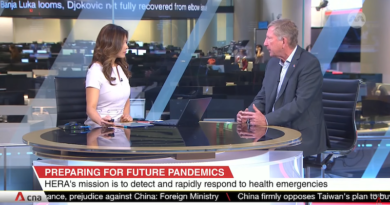
A pharmaceutical strategy for Europe to promote health security
Europe has always been a frontrunner in universal health, a global leader in healthcare research & development and a major trading partner in pharmaceuticals and medical technologies. However, the landscape is evolving rapidly. Digital transformation, scientific breakthroughs, globalisation, health system sustainability are some of the drivers bringing fast changes. Europe must lead the digital and sustainability transition and foster innovation for unmet medical needs.
This includes ensuring that the current regulatory framework on pharmaceuticals and medical technologies meets EU patients’ and health systems’ needs, while allowing the EU to remain a global industrial leader. To tackle these emerging challenges, the Commission adopted, on 25 November 2020, a Pharmaceutical Strategy for Europe1 to ensure that the European Union has sustainable access to affordable medicines and that the European pharmaceutical industry remains an innovator and world leader.
The Strategy is a building block of the “European Health Union” put forward by President Von der Leyen, in her September State of the Union speech, reinforcing the EU’s resilience for cross-border health threats2.
The current COVID-19 pandemic is a daily reminder of the importance of health and a policy framework for medicines that delivers on a consistent basis. The crisis itself did not give rise to completely new problems, but it has highlighted existing ones as well as flaws in the system that can have grave consequences in a crisis setting.
The crisis has taught us that we need to deal with such threats in a faster, more comprehensive and coordinated manner. It demonstrates the need to have a future-proof and crisisresistant system to ensure access to safe, quality and efficacious medicines under all circumstances. The impact of COVID-19 on the supply of medicines in the EU, in particular in stocks of intensive care unit medicines or increased demand of certain medicines, has shown the importance of anticipating, monitoring and managing the risk of shortages in a crisis, especially for critical medicines. Several existing tools and mechanisms such as advance purchase agreements, stockpiling, data pooling have been, and keep on being, reinforced through the crisis, and should be further operational permanently. Governance and preparedness become ever more relevant as part of a crisis-resistant system.
A reinforced role of the European Medicines Agency (EMA) and the European Health Emergency preparedness and Response Authority (HERA), as proposed by the European Commission last autumn, will be instrumental.
The EU has proven its benefit in coordinating, identifying potential treatments, diagnostics and vaccines, and alerting and mitigating shortages of essential medicines. The European Health Union package, announced on 11 November, will further reinforce EMA’s mandate to effectively monitor and mitigate shortages. This will include a digital platform for reporting information regarding available stocks and shortages of medicines and medical devices. Interagency collaboration (between EMA, and other EU and national Agencies) is crucial for knowledge exchange and crisis management. HERA, on the other hand, will anticipate threats and enable technologies and countermeasures through investment in public private partnerships. The Commission will adopt its proposal for this new Agency in the second half of this year.
The challenge of shortages is not only present at times of crisis. The Pharmaceutical Strategy commits to analyse the complex root causes of shortages and propose solutions. As a first concrete step, the Commission launched, on 26 February, a structured dialogue in cooperation with actors of the pharmaceutical supply chain to address potential vulnerabilities of the functioning of the global supply chain.
The supply chains for many medicines are indeed long and the causes for shortages complex, therefore requiring holistic answers.
Under the Pharmaceutical Strategy, the Commission will map the manufacturing capacity in the EU, analyse the root causes of shortages, as well as identify active pharmaceutical ingredients and the products that are critical from the point of view of public health and vulnerable from the point of view of supply.
Such evidence-based assessment, to be notably discussed with the industry, will allow evaluating if the current framework is fit for purpose, and provide potential solutions to address the issue and design the system in a way that it is less prone to shortages. The pharmaceutical strategy is not only a response to the issues highlighted by the COVID-19 crisis, but also a response to the need for creating a strong and future-proof pharmaceutical legislative framework. COVID-19 has highlighted the need for a framework that enables innovation to develop therapeutics and vaccines.
Besides, new generations of medicinal products, such as combinations of pharmaceuticals and medical devices, are testing our legislation. Our ambition is to develop a lasting legislative framework that benefits from digitalisation and reduces regulatory burden while continuing to ensure the quality and safety of medicines. The evaluation and revision of the EU pharmaceuticals legislation will consider how to make best use of new methods of evidence generation and assessment, such as artificial intelligence, the analysis of big and real world data to support the development, authorisation and use of medicines.
A conducive regulatory environment through the planned creation of a European Health Data Space will support these transformations. Regulatory flexibility and “platform technologies” could benefit high quality, coordinated clinical trials supported by an EU-wide clinical trials network. Combined with simplification and streamlining of our regulatory processes, such changes will lead to overall better coherence and make the EU system more appealing.
The Pharmaceutical Strategy for Europe seeks to strike the right balance between market protection and data exclusivity that guarantee a return on investment for companies and the need to ensure that the resulting medicinal products are available across the EU.
This system of ‘incentives and obligations’, as we call it, is a key part of the revision of the general EU pharmaceuticals legislation. The notion of ‘unmet medical needs’ is pivotal in that sense as it could define the areas where innovation could receive additional support. The ongoing review of medicines for rare diseases and for children under the Strategy contributes to our thinking. Antimicrobial resistance (AMR) is another major threat, identified as such for many years, since it decreases our ability to treat infectious diseases. It is a multifactorial and global issue, with serious health and economic ramifications.
The strategy will tackle the issue in two ways: measures to reduce their use and ensure appropriate use of antimicrobials, and measures to incentivise the development of new classes of antimicrobials. The Strategy includes a sustainable dimension as it links with the Green Deal and sustainability goals. It aims, among others; to strengthen the environmental risk assessment of medicines and address the environmental challenges, in particular to address the AMR also from this angle. Finally, the Strategy also ensures a strong EU voice globally, for which the ongoing cooperation with international partners at multilateral and bilateral level is key. I want to stress that the Strategy sets out a long-term vision.
2021 marks the beginning of a process that will ensure the EU’s pharmaceutical policy delivers and serves public health in an economically, environmentally and socially sustainable manner. Its success will depend on the commitment and contribution of all actors in the pharmaceutical value chain to build common ownership, and ultimately to contribute to the building of the European Health Union.




